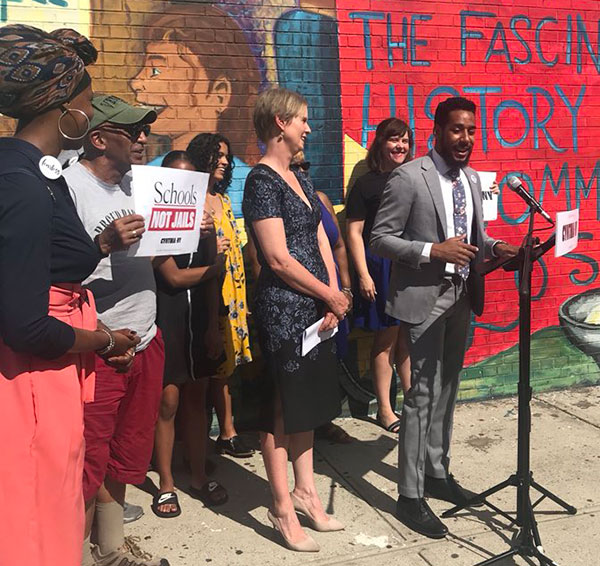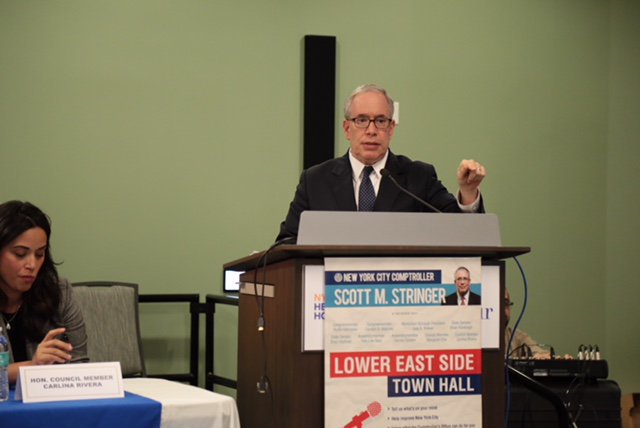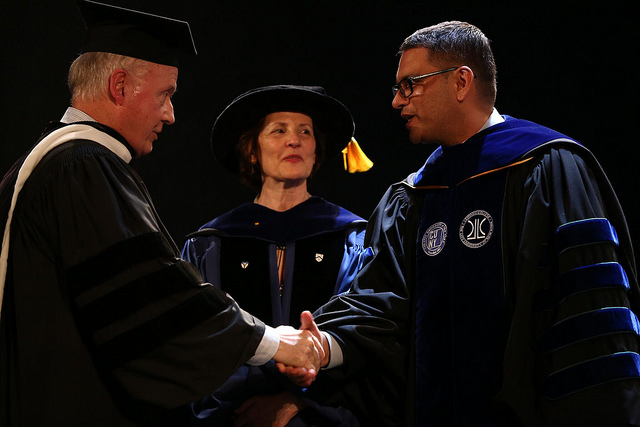I’m with Cynthia Because She Stands for Schools, Not Jails

Antonio Reynoso, the author, endorses Cynthia Nixon (photo: @CMReynoso34)
Last week, I endorsed Cynthia Nixon for Governor because her campaign is focused on making sure young people of color across New York thrive in school, rather than wither away in jail. As a City Council member from a predominantly black and brown community in Brooklyn, I constantly hear from young people who know what they need to succeed in school and what stands in their way.
Right now, there are more police in New York City schools than there are guidance counselors and social workers combined. What message does that send our children?
It is time to drastically change course in how we invest in the lives of black and brown young people. Talking to friends and allies across the state, the stories and experiences of the young people in my district are strikingly similar to those of young people across New York, from the Hudson Valley to Syracuse and beyond—because, while we can draw geographical lines to separate their school districts, it’s the color line that ensures they will all still be impacted by racially discriminatory school discipline policies and practices.
These policies have created a school-to-prison pipeline that afflicts young people of color across the State of New York. As Governor, Cynthia Nixon is committed to transformative policy changes to dismantle this system. That’s why a central part of her #SchoolsNotJails platform is school climate reform. Cynthia’s plan will push New York to lead the way by creating a Restorative Practices Training department within the State Department of Education to support schools in implementing restorative practices, introduce legislation to end school-based arrests for misdemeanors and violations, support schools to remove ineffective security measures, such as law enforcement and metal detectors, and only use suspensions as a last resort.
In New York State, there are over 500 suspensions per day and a disproportionate number of our young people being suspended are students of color. Statewide, one in five black boys are suspended from school each year; for black girls, it is one in seven. In New York City, black students are 27% of the population but nearly half of all students suspended; in Kingston they are 14% of the student body but 36% of all suspensions; and in Troy, they are 31% of the population but 61% of all students who are expelled.
The racial disparities in the statistics on referrals to law enforcement are just as alarming. In New York City, black and Latino students are 92% of all students who receive a summons; in Schenectady, black and Latino students are 75% of all students referred to law enforcement; and in Buffalo, black and Latino students are 85% of all students referred to law enforcement.
These disparities begin in pre-kindergarten, where black students are 3.6 times more likely to be suspended from school. And they continue through high school and beyond—one suspension in high school doubles the likelihood that a student will drop out before graduation and it denies students from critical instructional time. Last year, students in New York lost 686,000 days of instruction because of suspension. If the school discipline gap continues, it’s no wonder that our state is struggling to close the graduation gap.
Those numbers alone should be enough evidence to convince Governor Cuomo to take steps to dismantle the school-to-prison pipeline. But instead of confronting this reality, under his leadership, New York has done nothing to curtail the school-to-prison pipeline.
The young people I meet with are clear that the way forward is not to continue to “harden” their schools and rely on ineffective and harsh school discipline and policing, but to ensure equity in school discipline policies and practices and reimagine our approach to safety. There is no evidence that police officers and metal detectors make schools any safer, but there is ample research that shows they makes students feel less safe and result in more young people being pushed in front of police officers, prosecutors, and judges instead of guidance counselors, social workers, and school administrators.
Students feel safest in their schools not when they know technology exists that track their every move, or police officers do random checks and sweeps, but when they have staff trained in trauma-informed care, restorative practices, and youth development that are there to attend to their needs and create an inclusive environment.
Young people in my district are leading the way in demonstrating what safe and supportive schools can look like. Many of these schools are implementing restorative practices with real results -- dramatically decreasing suspensions and building strong school communities. This year my district saw one of the largest decreases in suspensions across the city. We can replicate this and transform schools into the safe and supportive learning environments our students and families deserve.
New York needs a public school system that is completely disentangled from the criminal justice system and a commitment that we are creating a nurturing and supportive environment for all students. This is the commitment that Cynthia Nixon is making. We need to invest in schools, not repeat the same policy failures that have led to our children ending up in jails.
***
Antonio Reynoso is the City Council member for New York’s 34th Council District in Brooklyn. On Twitter: @CMReynoso34.
***
Have an op-ed idea or submission for Gotham Gazette? Email This email address is being protected from spambots. You need JavaScript enabled to view it.
Fixing the City's Broken Approach to Nonprofit Contracting

Comptroller Scott Stringer, a co-author (photo: @NYCComptroller)
From housing for homeless families to meals for our seniors, non-profit organizations are on the front lines of our city, supporting our most vulnerable neighbors. Yet these groups are surviving hand-to-mouth when it comes to funding and often it’s our own city government that’s stalling the contracting process and delaying payments that thousands of nonprofits rely on.
In a new report, New York City Comptroller Scott Stringer’s office looked at thousands of human service contracts, and found an astounding 90 percent were submitted to the Comptroller’s Office for registration by a City agency after the contract start date had already passed, with half of them arriving six or more months late. Some agencies, including the Department of Homeless Services and the Department of Education, submitted over 99% of their contracts late.
The consequences of the City’s chronic lateness are huge. Because vendors don’t get paid until their contracts are registered, widespread delays in the contracting process force cash-strapped nonprofits to take out loans, miss payroll, or potentially cut services, just to deal with the shortfall in cash. In the last fiscal year alone, nonprofits took 751 City-issued bridge loans worth $149.9 million in total to keep the wheels turning as the City slowly processed their contracts.
It’s unacceptable. The burden of the City’s sluggish procurement process shouldn’t fall on our non-profit partners. That’s why we’re calling for common-sense reforms to break through the bureaucracy.
The City should build a public tracking system for contracts. If you can track a package as it moves across continents, you should be able to track contracts as they move through City agencies. Moreover, the City must develop clear metrics and strict timeframes throughout the procurement process, which will bring a basic level of transparency and accountability into this system.
Consider this: a non-profit is awarded a City contract to provide job training, with a specific start date for summer programming. That contract then goes through multiple layers of bureaucracy at the contracting agency before going over to some, if not all, of the following oversight agencies for review: the Mayor’s Office of Contract Services, the Law Department, the Office of Management and Budget, the Department of Investigation, and the Division of Labor Services at the Department of Small Business Services.
These levels of review are crucial and help to safeguard the integrity of the City’s public procurement process, rooting out waste and fraud. But as these agencies are not held accountable to deadlines, the full process can take months or even years to complete before the contract arrives at the Comptroller’s Office for registration.
In the end, the non-profit is left waiting for its contract and subsequent payment, without information on the process. This forces hundreds of non-profits into an impossible catch-22: wait to begin work, which can stall vital services and drive up costs – and in reality is rarely possible – or begin work without a registered contract, which can jeopardize the organization’s finances.
But with strict time-frames and a tracking system, non-profits might be spared this turmoil and gain some control in a process that currently treats their ability to function and help thousands of New Yorkers as an afterthought.
What we’re putting forward is a blueprint for the City to do better. Making these fixes will bring the contracting process in line with the City’s priorities, because behind these contracts are people who need food to eat, a roof to sleep under, or someone to care for them. These people are our neighbors, our relatives, and our friends. And right now, the snail’s pace of City agencies is putting their care at risk.
***
Scott Stringer is New York City Comptroller and Jose (Joey) Ortiz, Jr., is the Executive Director of the NYC Employment and Training Coalition. On Twitter @NYCComptroller and & @JoeyOrtizJr of @NYCETC_org
***
Have an op-ed idea or submission for Gotham Gazette? Email This email address is being protected from spambots. You need JavaScript enabled to view it.
CUNY’s Turn to Provide Paid Parental Leave for All

Macaulay Honors College commencement (photo via CUNY)
She hid her growing belly under loose dresses and oversized sweaters when she taught her classes of 30 college students. She avoided the departmental office during normal work hours, retrieving her mail early in the morning. If someone realized she was pregnant, she worried, some excuse would be found to deny her work for the next semester. With a baby on the way, losing her job would have put her and her spouse over the financial edge on which they delicately teetered.
Finally, after securing work, the adjunct faculty member relaxed and let her pregnancy show. Still, she worried about the due date. If there were complications, would she be able to return to work within a week as her employer required?
A story from a past generation? No. At CUNY, many adjunct faculty members – called “part-timers”– avoid telling their department chairs and colleagues about an impending pregnancy because their work is contingent from one semester to the next and they fear non-reappointment. Pregnancy discrimination is difficult to prove as adjuncts can be denied employment for any reason or no reason at all.
Even after that hurdle is successfully cleared, CUNY requires that a woman return to work a week after giving birth. Often, this is difficult for the mother and child. Sometimes, it is impossible. Then, she faces the peril of being unilaterally fired, losing her health benefits as well as her income just when she needs them most.
Sometimes co-workers willingly contribute unpaid labor to spell the new mother in the classroom and kindly administrators look the other way. But in many cases, it seems “easier” to find a new part-time faculty member to teach a class than to provide accommodations for the pregnant one. This discrimination arises from chronic understaffing, the well-worn trope of “interruption” to students’ education, and, especially, a pervasive attitude that, even though they teach more than half of all CUNY courses, adjuncts are seen as little more than the labor they provide.
CUNY still pointedly disavows any institutional responsibility to even long-time workers. Adjuncts don’t even have the right to “bank” unused sick days from one semester to the next, and the oddity of counting only their classroom hours as “work time” makes most ineligible for even the limited protections of the Family Medical Leave Act.
We are hopeful, though, that CUNY will soon see fit to enter the 21st century. Recently, two New York faculty unions, United Federation of Teachers and SUNY’s United University Professors, have won paid parental/caregiving leave for their members. And CUNY’s new interim chancellor, Vita Rabinowitz, is a renowned feminist scholar. While working at Hunter College, she was the founder of the Gender Equity Project, intended to clear away obstacles facing women faculty. At a recent Board of Trustees meeting, over a dozen adjuncts asked her to utilize a new state law as a vehicle for the kind of workplace justice she pioneered earlier in her career.
Under New York Paid Family Leave, workers pay a small supplement and receive partial pay and the right to return to their job for up to 12 weeks after childbirth, adoption, or to care for a sick family member. While private employers are required to implement the PFL, unfortunately, public employers, such as CUNY, can choose whether to opt in or not. So far, CUNY has failed to do so.
Currently, CUNY has over 15,000 “part-timers” who need relief from uncertainty. It’s time for their employer to provide this small modicum of security and stability. Then, paid family leave would make CUNY a place where pregnant women can proudly display their bellies for all the celebration that creating new life brings.
***
Pamela Stemberg is an adjunct lecturer teaching at CCNY and Hostos College. Marc Kagan is a graduate assistant teaching at Lehman College.
***
Have an op-ed idea or submission for Gotham Gazette? Email This email address is being protected from spambots. You need JavaScript enabled to view it.




